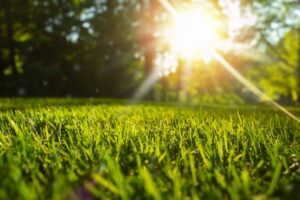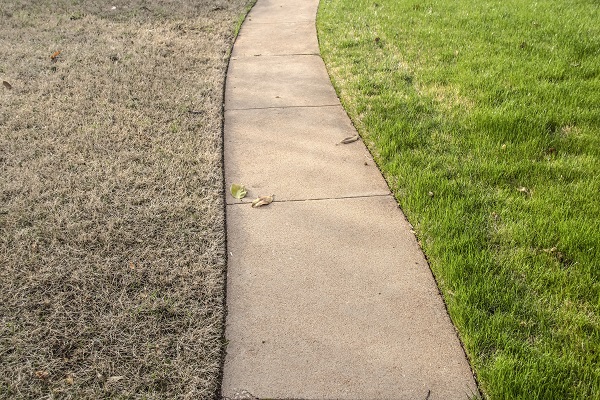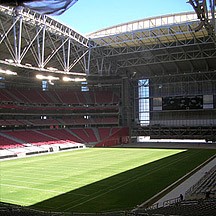9 Eco-Conscious Ways to Tend to Your Arizona Sod Lawn
Tuesday, January 24th, 2023If you have an Arizona sod lawn, making a care plan can be challenging. For one, the state features 10+ USDA Plant Hardiness Zones, and seasonal changes vary drastically by region.
If you live in one of the state’s drier areas, how can you balance the desire for a bright green lawn with an eco-friendly lifestyle?
In this guide, we’ll break down nine tips for eco-conscious lawn care specifically tailored to Arizona residents. While some of these suggestions may require a little extra elbow grease, others rely on simple science. Whichever you choose, incorporating even one of the tips below will help you maintain your lawn with the planet in mind.
#1 Beware of Overwatering
There are three important things to remember about overwatering your lawn:
- It can damage your grass – Overwatering can create shallow root systems, reduce your lawn’s tolerance to environmental changes (like drought), and provide a prime environment for unsavory insects.
- It’s not eco-friendly – Water may be a renewable resource, but droughts can be especially impactful in dry climates like Southwest Arizona. Avoid unnecessary demands on the water supply by watering thoughtfully.
- It’s expensive – Water isn’t free; overwatering your lawn could become expensive fast.
Instead of overwatering, follow a few sensible guidelines that can keep your lawn green:
- Irrigate early in the morning or in the evening to ensure optimal absorption.
- Use the same amount of water all year long, but adjust your frequency seasonally
- e., water less frequently in the rainy season than you do when it’s dry
- Control your weeds to ensure that your grass is getting the majority of the water
These practices will benefit your lawn, the environment, and your wallet—a win-win-win.
#2 Use a Push or Electric Mower Instead of a Gas Mower
Gas mowers aren’t the most eco-friendly option for trimming. They require gasoline to operate—a finite resource—and they release greenhouse gas emissions during combustion.
If you’re ready to adopt environmentally conscious mowing, you have two choices. You can:
- Switch to a manual push mower that doesn’t use gas
- Opt for an electric mower
Battery-operated mower technology is only improving; some models boast up to an hour of runtime, and lawn care gurus have numerous brands to choose from.
And, if you want to double up on your environmentally-friendly efforts, you can charge your batteries using solar power. What could be greener than a fossil fuel-free lawn?
#3 Swap Your Leaf Blower for a Rake (Or an Electric Blower)
Raking leaves was a childhood chore for many, which may have taken some of the charm out of the activity. But using a rake or electric leaf blower instead of a gas-powered one is a much more eco-conscious method (for the same reasons a gas mower isn’t the greenest choice).
And, like mowers, electric leaf blowers are getting better every year.
For proof, just take a look at the Ego Cordless Leaf Blower: It blows 765 CFM (more if you opt for the high-capacity battery), which beats even some gas-powered, backpack blower models.
Starting to notice a theme? If you’re trying to create green habits and a green lawn, consider swapping out your gas tools for electric or analog models.
#4 Focus on Native Plants
One of the simplest ways to create an eco-friendly lawn is to foster native grasses—or varieties that thrive in your climate without significant maintenance. Since most grasses native to Arizona don’t create the thick, lush lawns that homeowners love, turf experts recommend a bermudagrass hybrid that’s well-adapted to Arizona’s various climates, like Midiron.
Midiron offers a variety of benefits:
- It’s relatively drought-tolerant
- It recovers quickly from damage (e.g., foot traffic)
- It thrives at a variety of mowing heights (so it can be cut safely with just about any mower)
However, grass likely isn’t the only thing in your yard. To optimize eco-friendliness (and add more visual interest to your lawn), consider adding native plants like:
- Marsh aster
- Hedgehog cactus
- Ironwood trees
- Desert chicory
As an added bonus, keeping your lawn native is closely related to our next tip: keeping it local.
#5 Buy Native Sod from Local Businesses
With so many sod options on the market, one of the best ways to choose the best one is to consult an expert, like a local turf business. But why should you choose a local business over a big-box home improvement store or online grass seed supplier?
The biggest benefits of buying local include:
- Local ecosystem knowledge – Sod companies in your region know which species thrive under local conditions. They can help you choose a variety that has a high chance of survival in your neighborhood.
- Troubleshooting – If your lawn starts to wither six months after installation, a local supplier can make a house call. Local turf purveyors live in your neighborhood, too—they’re invested in the success of your yard.
- Environmental impact – A big box store or an online seed shop might need to send a semi-truck cross-country to deliver your product. You can reduce your footprint by ordering sod from your own ZIP code.
#6 Don’t Overseed in the Winter
Overseeding with a perennial species (like ryegrass) might enhance the aesthetics of your yard during the winter. But, to take root, these additional seeds require a lot of water.
Contending with cooler weather while committing to eco-friendliness means accepting that your lawn will go dormant—a natural process that might make your yard (temporarily) a little less vibrant. However, skipping overseeding and accepting nature’s seasonal cycle can reduce any potential negative impact a pristine year-round lawn can have.
#7 Fertilize Your Lawn with Compost
Plants can’t discern between organic fertilizers (food made from other naturally-derived sources) and “chemical” fertilizers (commercially-available synthetic compounds).
Most chemical fertilizers are safe to use. But why spend money on chemical fertilizers when you likely have everything you need to create nutritious plant food at home? Enter: composting.
You can start fertilizing with compost without taking a single trip to the hardware store:
- Collect compostable scraps, like eggshells, fruit and vegetable peels, coffee grounds, and yard trimmings like dead grass and fallen leaves
- Let everything decompose for a few weeks while it breaks down into soil-like matter
- Sprinkle the compost around your lawn, as you would with a chemical fertilizer
#8 Test Your Soil
A soil test can provide critical information about your yard, like the pH of your soil (how acidic or alkaline it is), the nutrients present in (and missing from) your soil, and what nutrients are needed to achieve peak soil health.
All these data points can help you create a healthy environment where your sod (and other plants) can thrive. And, instead of experimenting with different methods (like additional watering or nonspecific fertilizer treatments) and hoping for positive outcomes, you can determine exactly what your yard needs to improve and take any necessary steps right away.
#9 Hand-Pull Your Weeds
If you’re trying to reduce the environmental impact of your lawn, it’s time to ditch the 2,4-D and don your weeding gloves. Pulling weeds by hand is significantly better for the environment than treating your yard with herbicide sprays.
While herbicides might kill your weeds, they don’t disappear from the ecosystem. And when they flow away with runoff, they have the potential to:
- Dissolve into the water supply
- Kill other healthy plants in the ecosystem
- Change the behavior or reproduction habits of fish, invertebrates, and amphibians
You can eliminate these possibilities by switching to manual weeding—your local flora and fauna will thank you.
Evergreen Turf: Keeping Arizona Green for Over 20 Years
Whether you’re looking to green-ify every element of your lawn care or phase in just a few eco-friendly tactics, it’s easy to make your yard maintenance routine a little more sustainable.
If you need expert landscaping advice or high-quality sod, turn to Evergreen Turf.
Since 1999, we’ve been supplying Arizona with elite, golf-quality turf that turns heads—and service that keeps homeowners and sports facility managers alike coming back. Browse our blog for more sod tips, or stop by our Chandler location to chat with a pro.
We can’t wait to see your yard flourish.







 It’s that time of year again…time for the Arizona Cardinals training camp which includes 18 practices and two preseason home games going on now through August 24. It’s free and open to the public, giving Cardinals fans the opportunity to watch the pro football players practice on the NFL’s top grass field, according to player surveys.
It’s that time of year again…time for the Arizona Cardinals training camp which includes 18 practices and two preseason home games going on now through August 24. It’s free and open to the public, giving Cardinals fans the opportunity to watch the pro football players practice on the NFL’s top grass field, according to player surveys.